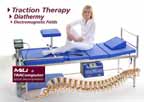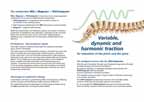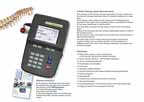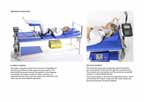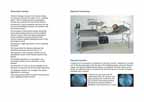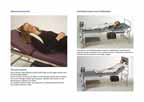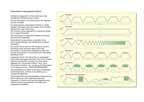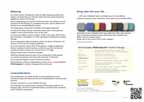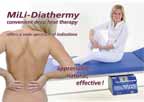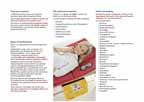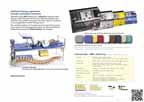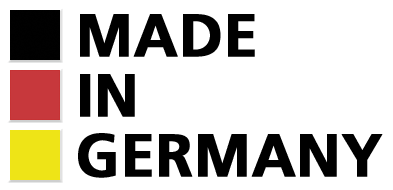 English Prospectuses
English Prospectuses
TRAComputer PDF-Screen version 1.1MB PDF-Print version 5.6MB
MiLi-Diathermy PDF-Screen version 1.3MB PDF-Print version 5.9MB
Text: TRAComputer traction-therapy
Text: Traction Therapy, HF-Diathermy
TRAComputer + MiLi Table of diathermy therapy
Combination MiLi + TRAComputer
The combination MiLi / MagnoLi + TRAComputer MiLi, MagnoLi + TRAComputer is the name of an unique apparatus combination of the proven, patented basic components:
- TRAComputer for longitudinal electromotive traction or for traction of the extremity joints
- High frequency diathermy by the MiLi (microwave couch) principle
- MagnoLi – magnetic field therapy
Medicine, biochemistry and biophysics require, for traction treatment, promotion of metabolism and, especially, a relaxation of the muscular tissue and connective tissue at the critical sites.
High frequency diathermy (e.g. irradiation with microwaves) is predestined for this objective.
HF-Diathermy - electromagnetic signals
Only high frequency radiation penetrates the cutaneous and fatty layers almost unimpeded. The high frequency electromagnetic energy is converted into heat only when it reaches the lower-lying water-containing tissue, and hence at the critical sites.
From this favorable starting point, high frequency treatment at the same time as traction shows particularly good healing effects. This is chiefly due to the elasticising action on the vertebral tissue, coupled with hyperaemisation and increased phagocyte function.
Conventional sources of heat scarcely reach the critical sites in the low-lying endogenous regions, since the circulation has already removed the heat beforehand, and furthermore the tissue has only a limited heat conductivity.
Advantages of combination therapy
A cumulative and hence a potentiating effect is achieved by combining traction therapy and simultaneous high-frequency-diathermy. The outstanding peculiar advantages of high-frequency-diathermy by the MiLi principle also contribute to these effects.
The intelligent traction with the TRAComputer
With the aid of pulsation therapy new therapeutic approaches through variable, dynamic and harmonic oscillations. By graphical displays, an intelligent dialogue exists between the TRAComputer and the therapist. Incorrect operation is therefore excluded.
The computer system provides a large number of therapy programs by a very simple operation. The TRAComputer continuously monitors all conceivable safety routines, which give the therapist supports and releases.
So, for example, the TRAComputer permits the increased traction force for lumbar tractions if the cervical belt is not around the patient.
Optional accessory:
By the patients individual chip card system the personal therapy data can be stored in the memory of the TRAComputer. For further therapy sessions these informations are available. In this way computer inputs are furthermore reduced and offer a private patient account system.
Traction therapy, spinal decompression
The successes of the traction therapy, especially of cervical, lumbar and the hip joint therapy, have been known in physical medicine for a long time.
The lumbago, which makes up over 30 percent of all degenerative processes in the region of the vertebral column, is particularly a disease of very great importance in health politics.
The controlled, successful therapy causes a relief of the surrounding tissue. Easing of the foraminal and disc pressure additionally results in relief of the irritated nerves.
On the traction couch, the patient can be subjected to chiropractical or electromotive traction. The main field of use is lumbar and cervical traction, but also the traction of other joints is entirely possible with the assistance of additional belts. Even after a few therapy treatments, the patient may be free from pain.
Indications
- Dislocations, sprains, strains, subluxations in the cervical-, thoracal and lumbar vertebrae
- Acute cervical-, thoracal- and vertebral syndromes
- Chronic vertebral syndromes
- Brachialgias and Ischialgias
- Protrusion
- Neuralgic lumbar disorders
- Cervical syndromes with osteochondrosis and spondylarthrosis
- Cervical migraine
- Osteoarthritis
- Coxarthroses, arthrosis of all joints in the body
- Hip joint blockages
- Increased pressure in the foraminal space with intervertebral disc
- Diagonal traction for acute painful scoliosis
Standard accessories
Lumbar traction
The collars and belts provide the maximum of flexibility for the fitting to different body shapes of your patient. The belts should be placed around the patient so that slipping is excluded.
For lumbar vertebral column traction, it is essential that the thorax belt acts below the costal arch; this collar should never impede respiration.
Cervical traction
The patented, automatic recognition gives the patient the most optimal treatment through the cervical traction. The traction runs very gently, and the maximum potential traction is reduced automatically. The traction angle, in the vertical longitudinal plane, which is formed by the traction cable and the couch horizontal, should be between 30 and 45 degrees.
Horizontal traction
Traction therapy is known from ancient times. In contrast to traction by means of an „inclined plane“ and to vertical traction, psychogenic stresses are avoided with horizontal traction. Furthermore, precise metering and even for the first time intermittent traction are possible with horizontal traction.
The necessity of horizontal traction should be particularly emphasized for cervical vertebral column traction, since the desired separation of the vertebrae is scarcely achieved with vertical traction (patient sitting) because of the psychogenic stress.
Frequently, a slight separation is even caused by the stress. This means that the distance between the vertebrae decreases during traction ( ! ).
The kyphosis of the vertebral column can be adjusted by means of the flection stool for the shanks. The height adjustment or the angle to the horizontal surface is very critical for cervical traction. The direction of traction can be adjusted to all directions in space by extremely simple operation. For diagonal traction, for example, the lateral adjustment is necessary. The rolling section helps to avoid frictional losses when applying lumbar traction.
Optional accessories
Hip joint traction
A special set of accessories is required for hip joint traction. Treatment is carried out in the dorsal position with the leg in the angled position, using the flection tripod. The desired slightly lateral traction is caused by the lever action of the femur. An additional set of accessories for the axial hip joint traction therapy is available upon request.
Traction of a hip joint with 25° lateral abduction, 30° flection and approximately 20° rotation of the leg. In those most loose positions the hip joint traction obtains a dilatation from 0,5mm up to 1,2mm.
Optional accessories
Thoracal traction
The rucksack alike looking traction belt holds up the upper thorax over both shoulder-blades. So the traction force has an effect on the thoracal spinal system mainly. The more stronger lumbar spinal system transfers the traction to the thoracal part without any losses.
For smaller traction forces, arm loops are an adequate substitute for the counter-traction collar.
Extremity traction and mobilisation
The hand or foot belt should be used for mobilization training and traction of the extremities. No counter-traction is necessary, since this is achieved by the patients own body weight.
Intermittent and pulsed traction
Satisfactory separation of the vertebrae is only possible by relatively severe traction. On the other hand, over-stretching of the ligament must be avoided. For these reasons, intermittent traction is usually applied. This means that the traction force remains constant for only a short time.
The traction is then reduced for a relaxation phase, to rise again thereafter. This alternation is repeated throughout the entire period of the treatment.
Intermittent traction
Intermittent traction allows, especially of hip joint traction therapy, the maintenance of blood circulation. As a result of the action of the exogenic traction, the fibres of the muscular tissue react with contraction. It is therefore necessary to allow the traction force flanks to rise slowly and to fall slowly (creeping force).
Pulsed traction
In pulsed traction, the active force is overlapped with a light massaging vibration. This form is chiefly used for mobilization training. The force-/ time-diagrams for „force static traction“ and „force intermittent traction“ etc. are shown for illustration in the adjacent charts „TRACTION PROGRAMS“.
The parameters are either to be fed in individually via the keyboard, or they can be called up as a complete programme. The therapist thus has the possibility of determining all the values for each individual treatment manually or, if ever-recurring time sequences and relative tractions are desired, of selecting the programmes available.
Metering
For initial traction therapy by means of high frequency pulsed heat, stage 5, corresponding to 125 watt, (deep thermal action) should be applied for about five minutes.
Before undergoing any traction for the first time, the patient must be prepared for the therapy in a detailed discussion, and in addition the traction force should initially be lower.
The psychogenic mechanism is thereby favourably influenced. For the first lumbar traction treatment, about 30% of the patients weight is used as the traction force at the start.
For cervical vertebral column traction, 3daN is the upper limit for the first treatment.
The patient is in this way better introduced to traction therapy. At the subsequent daily treatments, which last about 15minutes, the traction force must be increased gradually.
As a rule of thumb, about 50% of the patients weight is applied for lumbar vertebral column tractions, whilst the top limit for cervical vertebral column tractions is a traction force of 12daN. Higher traction forces should be avoided. Attention should always be paid to the constitution of the patient, as a further parameter and reduce the intensity, if indicated.
In this way psychogenic tension will be prevented. Particularly by using low and pleasant traction forces, a very effective TRAComputer - traction therapy will be achieved.
Contraindications
Contraindications are based chiefly on local weaknesses of the connective tissue and bone due to acute inflammations, infections and tumours.
Traction treatment is a very effective therapy.
If no therapeutic result has been achieved after daily treatment for fourteen days, the form of treatment being used should be examined, and if necessary interrupted.
Bring color into your life . . . . . .
with your individual taste, we design your own upholstery. Choose a harmonic color, which fits to the style of your medical office.

Upholstery Colors: Standard color gray. Optional colors upon request.
Due to technical printing reasons, the shown color samples may differ from the original colors. Please ask for the current list of color samples!
Changes without any notice.
Technical Data
TRAComputer-Traction-Therapy
Couch: Not magnetizable stainless steel,
weight: 78kg Standard: height: 65cm, width: 75cm, length: 200cm
Basic area requirement: Width: 90cm, Length: 222cm,
special dimensions upon request
TRAComputer:
Traction unit, weight approx. 18kg Type/Group: UMDNS: 14-105; MPG: IIa; protection class: I TypeB
Traction load Cervical max. 12daN, lumbar max. 60daN ( 90daN special version)
Mains voltage: 230V~ ±10%, 50Hz, or 120V~, 60Hz; max. 80VA
Patents: Germany P 2701934; USA 4.316.474; Netherlands 79.07025; Italy 69288; Spain 484.793; Europa EP 0566836A2; EP 0334274 A2
Rev. 05/2013

